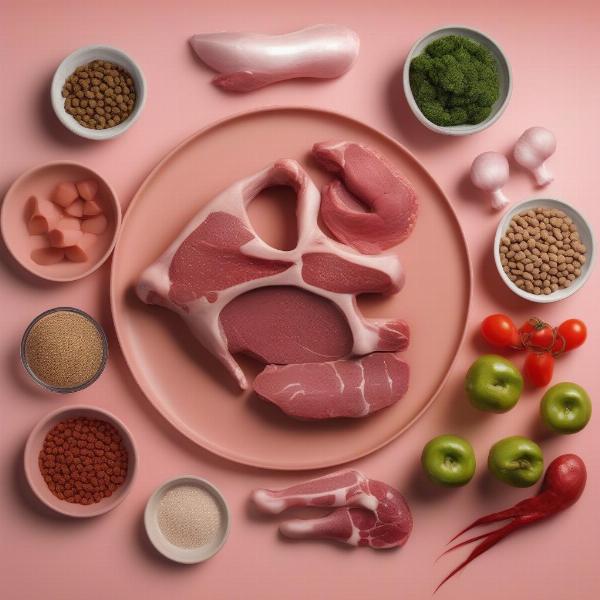Raw dog food, also known as the BARF diet (Biologically Appropriate Raw Food), has gained significant popularity among dog owners seeking a more natural and species-appropriate way to feed their furry friends. This diet typically consists of raw meat, bones, organs, vegetables, and fruits, mimicking the diet of wild canines. But is it right for your dog? This guide delves into the intricacies of raw dog food, exploring its benefits, risks, and essential considerations for making an informed decision.
Understanding the Principles of Raw Dog Food
The philosophy behind raw dog food is to provide dogs with a diet that closely resembles what their ancestors consumed in the wild. Proponents believe this approach can lead to improved health, shinier coats, increased energy levels, and better dental hygiene. Raw diets often focus on muscle meat, organ meat (like liver and kidney), edible bones, and a smaller portion of fruits and vegetables. It’s important to note that a balanced raw diet requires careful planning and understanding of canine nutritional needs.
Benefits and Potential Risks of a Raw Diet
Many dog owners report positive changes after switching to raw food, including improved digestion, healthier skin and coat, and increased vitality. However, raw feeding isn’t without potential risks. The primary concern is the risk of bacterial contamination, particularly from Salmonella and E. coli, which can pose a threat to both dogs and humans. It’s crucial to handle raw meat with proper hygiene and source ingredients from reputable suppliers. Another concern is nutritional imbalances if the diet isn’t carefully formulated.
Getting Started with Raw Feeding: Key Considerations
Transitioning your dog to a raw diet should be done gradually to avoid digestive upset. Start by introducing small amounts of raw food alongside their current diet, gradually increasing the proportion of raw food over several days or weeks. Working with a veterinary nutritionist is highly recommended to ensure the diet meets your dog’s specific nutritional requirements. They can help you create a balanced meal plan and address any concerns you may have.
Essential Nutrients for a Balanced Raw Diet
A complete and balanced raw dog food diet must include appropriate amounts of protein, fat, calcium, phosphorus, and other essential vitamins and minerals. This can be achieved through a variety of ingredients, including different types of meat, organ meat, and bones. Supplementation may be necessary in some cases, especially for growing puppies or dogs with specific health conditions. Always consult your veterinarian before adding any supplements to your dog’s diet.
 Balanced Raw Dog Food Meal
Balanced Raw Dog Food Meal
Is Raw Dog Food Right for Your Dog?
The decision to feed your dog a raw diet is a personal one that should be made after careful consideration and consultation with your veterinarian. Weigh the potential benefits and risks, and consider your lifestyle and ability to prepare and handle raw food safely. raw dog food delivery massachusetts can be a great option for busy owners. Remember, a well-balanced commercial diet can also provide complete and balanced nutrition for your dog.
Conclusion
Raw dog food offers a natural and potentially beneficial approach to canine nutrition. However, responsible raw feeding requires diligent research, careful planning, and strict hygiene practices. simply raw dog food offers convenience. By understanding the principles of raw feeding and working closely with your veterinarian, you can make an informed decision about whether this dietary approach is the right choice for your canine companion. Don’t hesitate to explore options like raw dog food bristol for local sourcing.
FAQ
- What are the most common ingredients in raw dog food? Raw meat (muscle meat and organ meat), edible bones, and a small portion of fruits and vegetables.
- Is raw dog food safe for puppies? Yes, but it’s crucial to work with a veterinary nutritionist to ensure their specific nutritional needs are met. dehydrated raw dog food is a convenient option.
- How do I transition my dog to a raw diet? Gradually introduce small amounts of raw food alongside their current diet, increasing the proportion of raw food over time.
- What are the risks of feeding raw dog food? The primary risks are bacterial contamination and potential nutritional imbalances if the diet isn’t properly formulated.
- Where can I find more information about raw dog food? Consult with your veterinarian or a certified veterinary nutritionist. You can also research reputable online resources dedicated to raw feeding. steve raw dog food provides quality products.
ILM Dog is a leading international online resource dedicated to providing dog owners with expert advice and information on all aspects of dog care and wellbeing. From breed selection to health, nutrition, training, and grooming, we offer comprehensive, practical, and trustworthy guidance to help you provide the best possible care for your canine companion. We specialize in helping dog owners understand their dog’s individual needs, including dietary requirements. Contact us at [email protected] or +44 20-3965-8624 for personalized advice. ILM Dog is your trusted partner in responsible dog ownership.